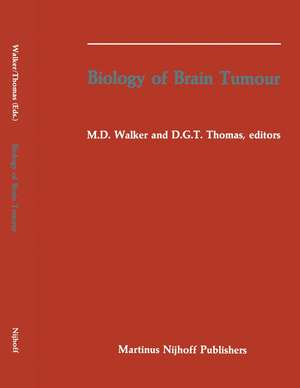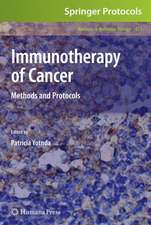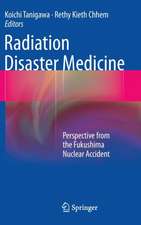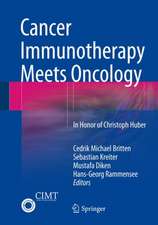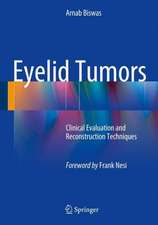Biology of Brain Tumour: Proceedings of the Second International Symposium on Biology of Brain Tumour (London, October 24–26, 1984)
Editat de Michael D. Walker, David G.T. Thomasen Limba Engleză Paperback – 10 sep 2013
| Toate formatele și edițiile | Preț | Express |
|---|---|---|
| Paperback (1) | 2134.21 lei 6-8 săpt. | |
| Springer Us – 10 sep 2013 | 2134.21 lei 6-8 săpt. | |
| Hardback (1) | 2138.61 lei 6-8 săpt. | |
| Springer Us – 30 oct 1986 | 2138.61 lei 6-8 săpt. |
Preț: 2134.21 lei
Preț vechi: 2246.54 lei
-5% Nou
Puncte Express: 3201
Preț estimativ în valută:
408.39€ • 436.70$ • 340.50£
408.39€ • 436.70$ • 340.50£
Carte tipărită la comandă
Livrare economică 17 aprilie-01 mai
Preluare comenzi: 021 569.72.76
Specificații
ISBN-13: 9781461294153
ISBN-10: 1461294150
Pagini: 528
Ilustrații: XI, 515 p. 139 illus.
Dimensiuni: 210 x 279 x 28 mm
Greutate: 1.18 kg
Ediția:Softcover reprint of the original 1st ed. 1986
Editura: Springer Us
Colecția Springer
Locul publicării:New York, NY, United States
ISBN-10: 1461294150
Pagini: 528
Ilustrații: XI, 515 p. 139 illus.
Dimensiuni: 210 x 279 x 28 mm
Greutate: 1.18 kg
Ediția:Softcover reprint of the original 1st ed. 1986
Editura: Springer Us
Colecția Springer
Locul publicării:New York, NY, United States
Public țintă
ResearchDescriere
This volume contains the proceedings of the Second International Symposium on Biology of Brain Tumour. The first Symposium was held in 1979 at Gardonne Riviera, Italy. This meeting was planned in order to coincide with the lOOth Anniversary of the first reported operation for glioma in London on November 25, 1884. Since the first meeting, the field of neuro-oncology has made remarkable progress in understanding both basic and clinical factors of significance to patients with brain tumor. While the earlier meeting dealt to a large extent with clinically oriented studies, this symposium was more heavily weighted toward the biology of brain tumour and improving our understanding at the physiologic, biochemical, pharmacologic, and cellular level. The meeting was divided according to scientific content into presentations and discussions as well as posters for more leisurely viewing, so as to allow the main themes of the meeting to sequentially develop. The first session dealt extensively with neuro-oncology at the molecular level and included considerable discus sion of material related to the babic biochemical milieu in which tumors originate, proliferate, and eventually destroy the brain. Classic neuropathology has been the mainstay of tumor identification and characteriza tion, however, the process of classification has become much more complex. The availability of a variety of new tools has allowed investigation into the validity of the more traditional classification systems as well as the development of newer biologically related concepts.
Cuprins
Section I. Molecular Neurooncology.- 1. Molecular Biology of Cancer.- 2. Two-Dimensional Gel Electrophoretic Protein Patterns in High-Grade Human Astrocytomas.- 3. Biochemical Studies of Primary Cultures from Human Astrocytomas: Observations on Cell Growth and Regulation of Glutamine Synthetase.- 4. Dibutyryl Adenosine 3?:5?-Cyclic Monophosphate (db-cAMP) Induced Growth Inhibition and Morphologic Changes in Human Medulloblastoma Cell line TE671.- 5. Phenotypic Modification of Human Glioma.- 6. Chromosomes and Chromosomal Progression of Malignant Human Gliomas: Theoretical and Practical Implications.- 7. Differential Expression of Neuron Specific Enolase and Creatine Phosphokinase-BB by Human Medulloblastoma and Glioma Tumors and Neuroectodermal Cell Lines.- 8. Neovascularisation of Intracranial Tumours.- 9. Red Blood Cell Polyamines in Malignant Glioma Patients. Spermidine and Spermine Blood Levels and Tumour Evolution..- Section II. Modern Neuropathology.- 10. Pathological Classification of Tumours of the Central Nervous System.- 11. Modem Neuropathological Investigative Techniques of Brain Tumours.- 12. Adenylate Cyclase Activity and Cyclic AMP Content in Human Central Nervous System Tumors and in Cerebrospinal Fluid of Patients Bearing Brain Tumors.- 13. Non-Nuclear Cytotoxic Actions of DNA Cross-Linking and/or Alkylating Agents in Glioma- Derived Cell Lines.- 14. Intracerebral Transplantation of D-54 MG Human Glioma Line in Immunosuppressed Rats.- 15. In vivo Characterization of a Human Neuroectodermal Tumor Cell Line.- 16. Carbonic Anhydrase C as a Marker Antigen in the Diagnosis of Choroid Plexus Papillomas and Other Tumours: An Immunoperoxidase Study.- 17. Transplacental ENU Tumors of the Rat: Immunohistochemical Contribution to the Recognition of Cell Types.- 18. Vascularization of Human Cerebral Gliomas: A Lectin-Cytochemical and Morphometric Study.- 19. Immunohistochemical Demonstration of HLA-DR Positive Cells in Normal and Neoplastic Brain Tissues. I. Preliminary Report.- 20. Primary Non-Hodgkin Lymphomas of the Central Nervous System.- 21. Evaluation of a Transplantable Mouse Brain Tumour: A Model for the Study of Human Glioma.- Section III. Correlates of Brain Tumour Imaging.- 22. Neuropathology and Imaging. The Ways in Which Glioma Spreads and Varies in Its Histological Aspect.- 23. Magnetic Resonance Imaging of Central Nervous System Tumors.- 24. Radioimmunolocalisation of Primary Cerebral Tumours in Humans.- 25. Histological Factors in the Prognosis of Malignant Astrocytomas.- 26. Correlation of Target Site with Histology and Cell Culture in CT-directed Stereotactic Biopsy.- 27. The Vasculature of Experimental Brain Tumours: Angiogenesis, Vascular Pathology and Per-meability Studies.- 28. An Autoradiographic Approach for Studying the Distribution of Neurotransmitter Receptor Binding Sites on Biopsy Samples of Human Gliomas.- 29. Drug Delivery to Brain Tumors: Physiological and Pharmacokinetic Aspects of Chemotherapy.- 30. Experimental Models of Rat Brain Tumors by Stereotactic Injection of C6 Glioma and HTC Hepatoma Cell Lines.- 31. Cerebral Infarction as a Result of Tumor Emboli.- Section IV. Surgical Neurooncology.- 32. Technical Approaches to Identification and Stereotactic Reduction of Tumor Burden.- 33. A Surgical History of Maida Vale Hospital.- 34. Pre-Operative Stereo-Scanning for Glioma Treatment Planning.- 35. Stereotactic Curietherapy of Thalamic Tumours.- 36. Intraoperative Radiation Therapy for Glioblastoma Multiforme.- 37. ‘Radical’ Surgical Decompression of Supratentorial Gliomas. Do the Results Justify the Opera-tion?.- 38. Laser Microsurgery: A Review of 110 Tumors of the Brain and Spinal Cord.- 39. Carbon Dioxide Laser Surgery For Malignant Glioma.- 40. Long Term Results of Ventricular Shunts Performed Prior to Posterior Fossa Operation for Tumor.- 41. Radical Laser Surgery in the Treatment of Gliomas.- 42. Preliminary Observation on the Use of the Local Thermochemotherapy in the Treatment of Malignant Cerebral Tumors.- 43. Remarks on the Surgical Treatment of Bilateral Transcallosal Gliomas.- Section V. The Biology of Radiotherapy.- 44. Radiation Damage to Brain and Cranial Soft Tissues: Outcome and Incidence Before and After Reduction in Dose.- 45. Radiotherapy with a Three-Fraction Per Day Regimen in a Split Course of Irradiation for Malignant High Grade Astrocytomas.- 46. Non-Invasive Thermochemotherapy for Advanced Brain Tumors.- 47. 252CF Neutron Brachytherapy for Malignant Glioma at the University of Kentucky and a Malig-nant Glioma Therapeutic Staging System.- 48. Permanent Radioactive Iodine Seed Implants Following Radical Resection in Recurrent Human Malignant High Grade Astrocytomas.- 49. Technique and Preliminary Results of Interstitial Irradiation for Recurrent Glial Tumors.- 50. Results of Definitive Irradiation for Optic Gliomas.- Section VI. Drug Therapy.- 51. Current Approaches to Chemotherapy.- 52. Cisplatin, Arabinofuranosyl Cytosine, and Caffeine Before Radiation for Glioblastomas.- 53. Multimodality Therapy of Supratentorial High-Grade Gliomas.- 54. The Use of Experimental Models of Human Medulloblastoma in the Design of Rational Therapy.- 55. Phase II Study of Novantrone (Mitoxantrone Hydorchloride) in Adults with Grade III—IV Astrocytomas.- 56. An Experimental Study of Xenografted Human Gliomas.- 57. Human Central Nervous System Pharmacology of Tiazofurin.- 58. Primary Therapy of Medulloblastoma with Surgery, Radiation, and Methotrexate and BCNU — A Pilot Study.- 59. Cyclophosphamide, Adriamycin, Vincristine, and Dexamethasone in the Treatment of Bulky Central Nervous System Lymphoma.- 60. Effect of Intracarotid Administration of BCNU in Rats.- 61. Intravenous and Subarachnoid Adriamycin in Experimental Meningeal Carcinomatosis: Tissue Concentration and Therapeutic Efficacy.- 62. Adriamycin in the Treatment of Malignant Meningiomas.- 63. Heterogeneity in Response of Short-Term Glioma Cell Cultures to Cytotoxic Drugs: Correlation of In Vitro Chemosensitivity and Relapse Free Interval.- 64. High Dose Polichemotherapy with Autologous Bone Marrow Transplantation in Recurrent Medulloblastoma. A Pilot Study.- 65. Phase I Study of Intraarterial Mitomycin-C for Recurrent Intracerebral Tumors.- 66. In Vitro Phase II Trial with the Human Tumor Stem Cell Assay as a New Brain Tumor Model for Drug Screening: Preliminary Results.- Section VII. Immunoneurobiology.- 67. Immunotherapy of Patients with Brain Tumors — Current Prospective.- 68. Effect of Interferons and an Interferon Inducer on Malignant Brain Tumors.- 69. Antigenic Heterogeneity of Human Glioma Tissue and Cell Lines (HGL) Defined by Monoclonal Antibodies (MAs).- 70. T-Cell Mediated Cytotoxicity in Human Glioma.- 71. Modulation of HLA-DR Expression and Growth Inhibition on Glioma Cells: Heterogeneous Responses to Interferon.
